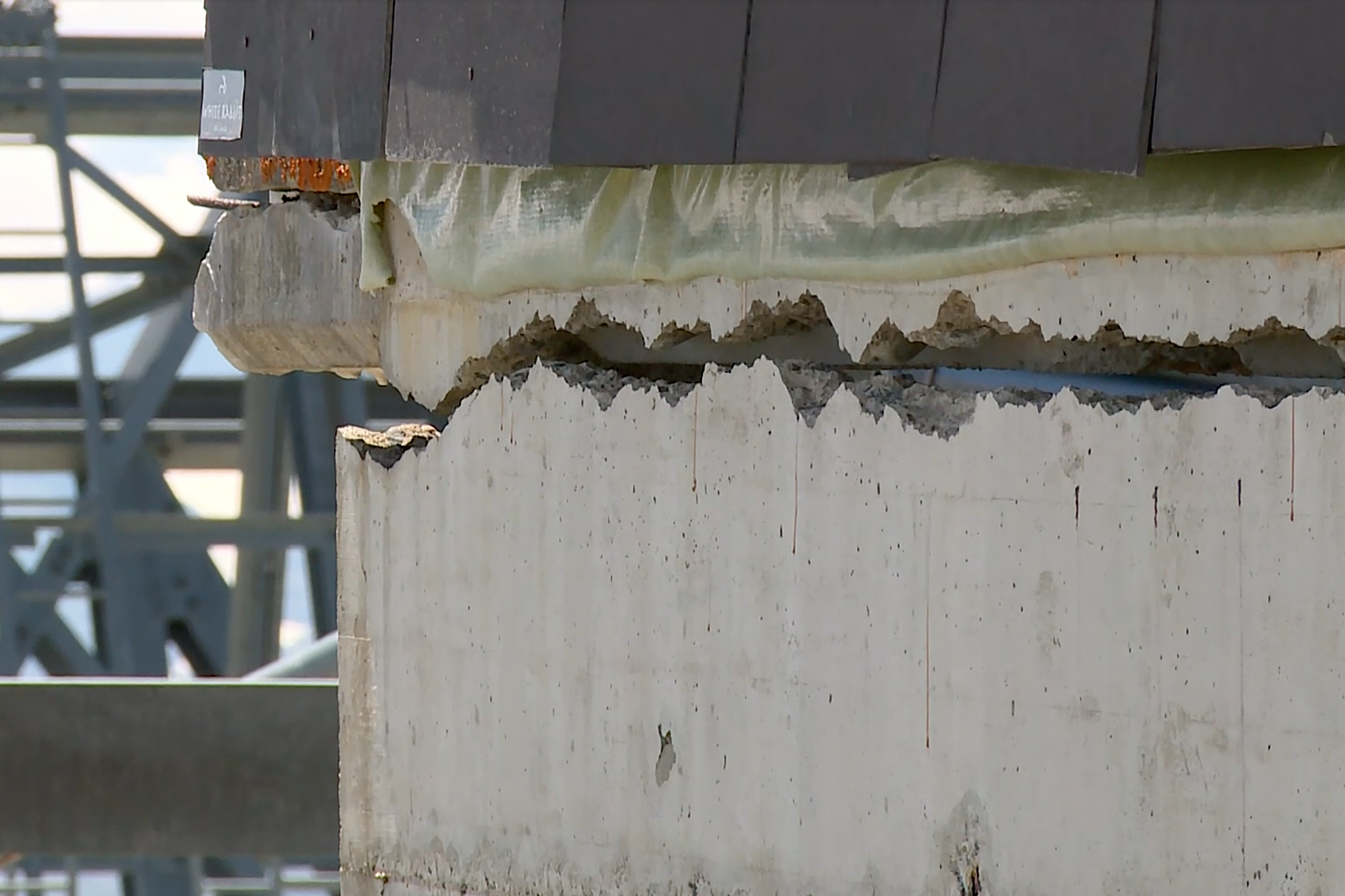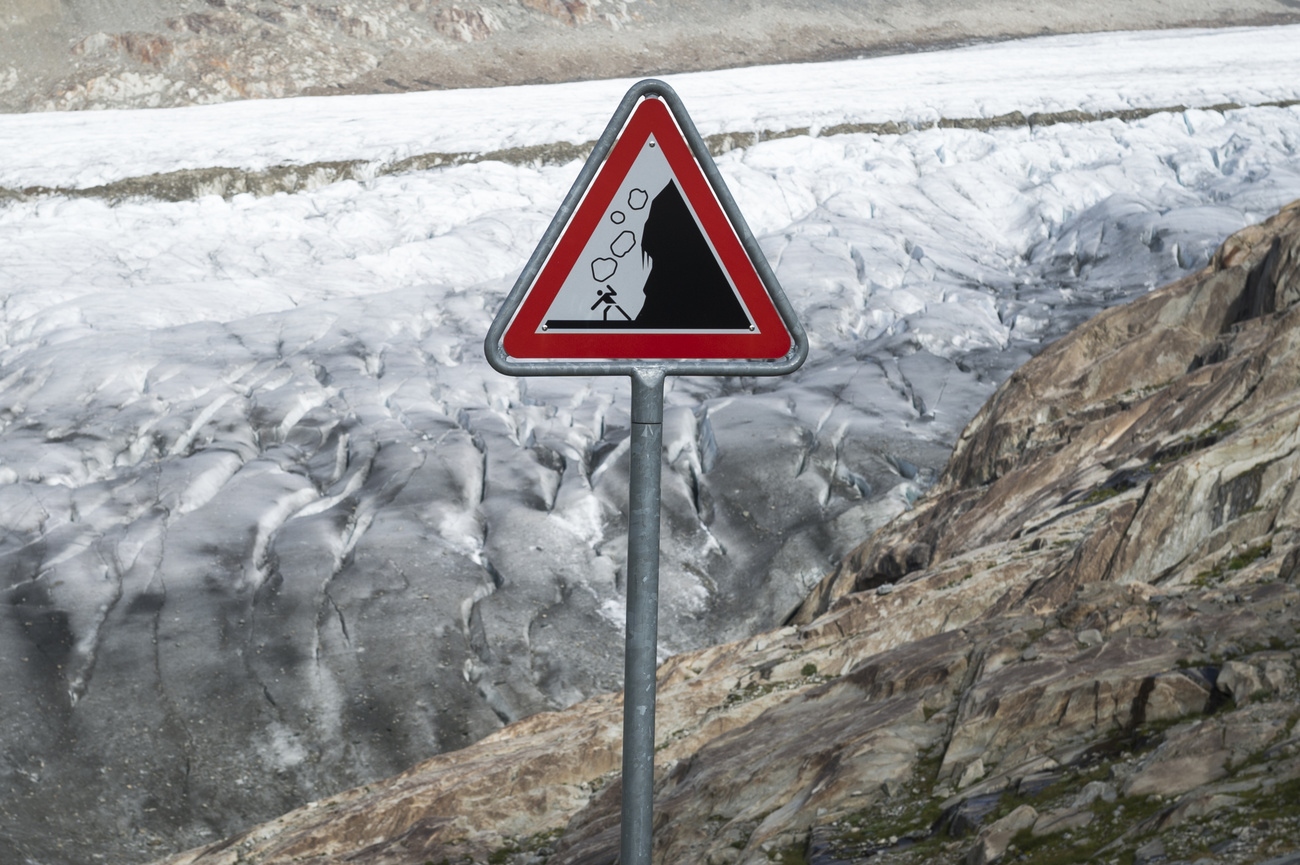
New hope for cable cars and mountain huts threatened by permafrost collapse

Thawing permafrost is transforming landscapes and presenting risks for railways, roads, cable cars and buildings. A novel scientific solution being developed in Switzerland aims to stabilise mountain infrastructure endangered by climate change.
“This is a hot topic right now,” says Elizaveta Sharaborova, a PhD researcher at the Swiss Federal Institute of Technology Lausanne (EPFL).
Sharaborova is working on “SolarFrostExternal link”, a project to develop a “thermal stabilisation” system that can prevent or delay permafrost thawing by using underground cooling pipes. The goal is to protect mountain huts, ski lifts, and railway lines that are built on the shifting ground.

“I’ve been talking to people in different countries – Germany and Austria as well as Switzerland – as they all have problems with infrastructure in the mountains,” she tells Swissinfo.
From the Alps to the Arctic, permafrostExternal link – the frozen underground mixture of soil, rocks, ice and organic material – is warmingExternal link. A study published last December revealed that permafrost temperatures in Europe’s mountain regions are rising higher and faster than ever before – over one degree Celsius a decade in certain placesExternal link. This can cause unstable slopes and rock falls, and it poses an existential risk for anything built on the frozen rock layer at altitudes above 2,600 metres.
While completing her mechanical engineering diploma, Sharaborova worked on a project to power railways using solar energy in Siberia; that was when it became clear to her how she might be able to preserve permafrost.
“It’s difficult to build infrastructure in some parts of Siberia as the soil is not very stable,” she tells Swissinfo. “We were thinking how we could use renewable energy to stabilise the permafrost. We proposed a system that includes a heat pump powered by solar panels, and that’s how it all started.”
From Siberia to Sion
Sharaborova moved to Switzerland in 2022 to study thermal stabilisation in greater depth – this time mountain permafrost – at EPFL’s Laboratory of Cryospheric Sciences in Sion in the heart of the Swiss Alps.
“It might sound cheesy, but I just want to participate in a project that can help the environment. I believe at some point my work will be helpful,” she says.
Various thermal stabilisation techniques, both passive and active, are already used in northern permafrost regions in Canada, Russia and Alaska where thawing poses a serious threat to roads and buildings and is altering the landscape. These include insulation and gravel embankments to minimise heat transfer, or ventilation ducts or thermosyphons. These simple systems have been used for over 50 years in many permafrost areas around the world to passively transfer heat from the ground to the air using natural convection and are deployed to help preserve permafrost and maintain slope stability.
But implementing such systems is difficult in high mountainous permafrost regions like the Alps. They become less efficient as the planet slowly warms and, if used in combination with cooling machines, are expensive and consume a lot of energy.
The EPFL researcher is aiming to address these issues with her “SolarFrostExternal link” project, an experimental thermal stabilisation system that she is developing and testing in Sion, canton Valais, and in Samedan, canton Graubünden.
Lukas Arenson, a geotechnical/permafrost engineer with the Canadian firm BGC Engineering, sees a definite need for such projects.
“As climate change progresses, there is a growing need to actively manage ground temperatures to keep permafrost frozen and maintain stability for various infrastructure in the Alps. Thawing permafrost may lead to ground displacements, and in some cases, even catastrophic structural failures.”

While the climate in the Alps differs from that of the Arctic, the physics remains the same—and so do the engineering principles, said Arenson.
Creating a sub-freezing layer
Sharaborova and her colleagues have built a solar-powered prototype to mirror real-world conditions. It consists of a one-metre-high thermally insulated wooden box full of soil to simulate mountain permafrost. Inside, it has been fitted with pipes containing coolant that are buried 10cm below the surface.
The pipes are connected to a heat pump, a device that circulates coolant fluid to absorb warmth from the ground and transfer it to the pump. In so doing, the system recreates a sub-freezing layer that would in theory protect permafrost below.
The entire prototype is powered by solar panels, which also shield the ground from solar radiation, reduce wind speed and protect from precipitation, further enhancing the cooling effect.
The experimental unit contains instruments to measure the soil’s temperature, moisture and heat flux. The intensity of the cooling can be adjusted via a compressor and switched on and off like modern floor heating.
Initial results are promising. Experiments show that the inexpensive system creates a frozen barrier layer that prevents heat from penetrating the ground, which in real permafrost can protect the deeper frozen layers in summer, while the solar panels should augment the natural cooling effect in winter.
>> This short video looks at the problems of thawing permafrost for mountain infrastructure and how the “SolarFrost” system works.
Another benefit is that heat extracted by the system or excess solar-generated electricity can also be re-utilised locally, for example, to heat or power a building or infrastructure in the mountains.
Her practical research builds on learnings from an earlier studyExternal link that points to the benefits of a combination of passive and active stabilisation measures for Alpine sites threatened by thawing permafrost.
‘Growing need’ for technical solutions
Specialists agree that this kind of research into technical solutions for cooling infrastructure in affected mountain regions is crucial but challenging.
“Permafrost temperatures are rising, active layer thicknesses are increasing and ground ice is melting. These processes can lead to subsidence and deformation of mountain infrastructure. Preventing them can prolong its design life and maintain its stability,” Marcia Phillips a senior scientist at the Swiss Federal Institute for Forest, Snow and Landscape Research WSL, told Swissinfo.
The main challenges for this kind of technology are its installation in complex mountain terrain and the fact the ground must be monitored closely during its use.

More
Melting permafrost threatens mountain regions. What can be done?
The concept of the SolarFrost project is sound, says Arenson, who has studiedExternal link construction methods on permafrost with Phillips.
“The idea of extracting heat from the ground—whether in winter or summer—is well established in permafrost engineering and has been successfully applied in cold regions around the world for decades. What stands out in this system is the use of a solar-powered heat pump,” he told Swissinfo. “I’d be particularly interested in seeing how the SolarFrost system compares to active thermosyphons in terms of efficiency—specifically, how much heat it can extract from the permafrost relative to the energy it consumes.”
High-mountain tests
Sharaborova’s next step is to create a larger scalable, sustainable version, which would be operational for a couple of years so that she can monitor how the technology works in high-altitude settings.
The precise applications of her technology are yet to be defined. Deploying it at large unstable permafrost slopes in the Alps is a definite challenge, she admits, as they would have to lay pipes in the mountain permafrost. But it could be used for cable cars or railways in the mountains. A similar solution is being tested at a Bus Tofana chairlift in the Cortina D’Ampezzo ski area in northern Italy to prevent or slow the melting process of permafrost.External link
The EPFL researcher, for her part, has been discussing with Swiss stakeholders from nearby mountain regions the potential impacts of thawing permafrost on high-altitude infrastructure.
And to reinforce an individual building in the mountains, such as a mountain hut, a thermal stabilisation system could be integrated into a basement, turning it into an underground freezer by attaching cooling pipes to walls. This would avoid the problems of installing pipes on inaccessible surfaces in the ground, she says.
“In northern regions like Russia or Norway, installing such systems is relatively straightforward,” explains the EPFL researcher. “But in mountainous terrain, the process is much more complex. The system must be optimised and integrated. This is really a big step to take this technology into the mountains.”
Edited by Gabe Bullard/vdv

More
How climate change is threatening permafrost’s delicate balance

In compliance with the JTI standards
More: SWI swissinfo.ch certified by the Journalism Trust Initiative































You can find an overview of ongoing debates with our journalists here . Please join us!
If you want to start a conversation about a topic raised in this article or want to report factual errors, email us at english@swissinfo.ch.